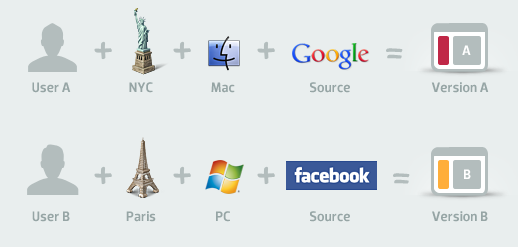 Conversion rate optimization is the marketing art of maximizing your investment in existing site traffic, through improvements and problem-solving rather than additional ad spend. At some point in any business site’s lifetime, CRO is a must; for smart marketers, it’s an ongoing process that pays dividends over and over again.
Conversion rate optimization is the marketing art of maximizing your investment in existing site traffic, through improvements and problem-solving rather than additional ad spend. At some point in any business site’s lifetime, CRO is a must; for smart marketers, it’s an ongoing process that pays dividends over and over again.
Once you’ve invested in attracting traffic to your site, whether to complete a purchase or take some other action, CRO helps ensure your visitors are engaged and converting at the greatest rate possible.
Some believe CRO happens only on-site, though attracting targeted prospects likely to convert through paid search ads, email marketing and landing pages, for example, is a critical step. Another misconception is that CRO is all about increasing the number of conversions. You like to make money, right? Optimizing for higher revenue conversions and increasing the value of each site visitor is another element of CRO that can’t be overlooked.
Of course, the larger your site and the more diverse your audience, the greater the task of optimizing for conversions becomes. Whether you’re tackling it in-house or using a consultant or agency, marketing software can help you better interpret the data available to you in order to improve your conversion rate and value per customer.
Your conversion rate optimization software solution may actually consist of a few different types of tools:
A/B, Multivariate Testing & Landing Page Optimization Software
Optimizely and Visual Website Optimizer are two examples of split-testing and multivariate testing software with a simple UI and no coding knowledge required. These are typically as easy to add to your site as Google Analytics code. You don’t need to actually create two (or more) versions of a page and run them against one another; your testing software will render a variation of your page in the user’s browser – there’s no IT involvement required. Visual Website Optimizer has a range of additional features including usability testing, revenue tracking and behavioral targeting, as well.
Geo and behavioral targeting can offer deeper insight into your customers’ journey to conversion.
In general, you need to consider:
- Ease of use. Look for a WYSIWYG interface, custom reporting against goals metrics, and code view if you’re more advanced.
- Conversion goals setting and tracking. Find a solution that allows you to establish and track multiple goals.
- Ability to test multiple pages at a time.
- Segmentation and personalization. You may want to test changes that would affect all site users, or only a select group.
- Integration with your analytics, lead capture, or other software.
Important: test your testing software. It only takes a few minutes and can save you a big headache with a new solution. Run an A/A test before you try any A/B or MVT tests. Think of this as calibrating the testing software you’re trying, except you can’t actually fix it (but you’ll know to move on if it’s not working for you!). Run your own page against itself. There shouldn’t be wild variations in conversion rates. If there are major differences, your testing software choice may not give you the most reliable insights.
You might find a testing software with landing page optimization functionality, or your needs might dictate you seek out another option. You might need a solution that integrates with Salesforce for lead capture, for example. Unbounce is worth looking into, with its landing page building, publishing, optimizing and testing features.
Site Analytics
In order to even begin optimizing your on-site experience for visitors, you need to understand how your presence on multiple channels affects and influences their purchasing behavior. Multi-channel funnels in Google Analytics allow marketers to see how site visitors research, compare, socialize, consider and make buying decisions across platforms.
Marketers get deep insight into assisted conversions, time lags, path length, and top conversion paths over the previous 30 days before conversion. It will take time to set up funnels for every page on your site, but this will allow you to see where, when and why people are leaving.
Social Advertising & Analytics
I wanted to mention this one specifically because social media is still written off too often as fluffy or lacking a definitive ROI. There is absolutely a wealth of information available from your social traffic and the ways you can use it for CRO vary. Take Facebook Check-Ins for a combination real-world and online retailer, for example. An offer of 10% off if you present your Facebook Check-In at the case register gives you the opportunity to know the exact order value for that social to in-store converting customer. Organic social analytics can also help you understand where your social users may be in the funnel, based on their engagement, questions and interactions.
Social advertising options, particularly Facebook, LinkedIn and Twitter Ads, have improved by leaps and bounds in the past 18 months. The targeting is far more granular and advertisers have a great deal of control over their campaigns on the self-serve platforms. Optimizing your PPC and social ads is critical in ensuring the people you are driving to your site are even going to be prospects for conversion.
In a recent blog post, Bryan Eisenberg reminds marketers to approach social landing page optimization with two important considerations in mind: Who are you and what do you do? Social media traffic is fundamentally different than search traffic, he says; social media landing pages must be thought of differently than search landing pages. However, ad and landing page best practices still apply: ads must be relevant, valuable and have a call to action, with landing pages that adhere to Eisenberg’s 10 point Anatomy of a Landing Page guidelines.
Try Before You Buy and Test, Test, Test
Did you notice we never talked about price? Remember that conversion rate optimization is one discipline in a holistic, balanced online marketing strategy. It’s not the be all that ends all and it’s not going to be your only investment this year. Some tools are free and most are quite reasonable, so if you find yourself quoted a sizable price for CRO software, seriously consider other options. Try out a few different CRO tools and test, test, test before you buy.
Many software providers also provide managed services for an additional fee. However, you may be better served by your agency or in-house team, who aren’t married to one tool and will switch if it would be beneficial for you.
Do you have a favorite solution? Share yours in the comments.
Top image from Shutterstock.



